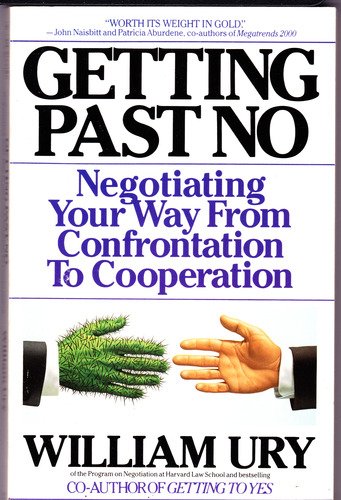Getting Past No
by William Ury
- Career
- Ashto =
- Jonesy =

Getting Past No will help you with daily life that is full of negotiations that can drive you crazy.
- Over breakfast you get into an argument with your spouse about buying a new car, your spouse thinks it’s time but you say “we can’t afford that right now”
- You arrive at work for a meeting with your boss, you present her with a carefully prepared proposal for a new project, but she interrupts within the first minute and says “we already tried that and it didn’t work.
- During lunch you try to return a defective toaster you bought last week, but the store person refuses to refund or exchange the toaster because you don’t have the receipt and that’s “Store Policy”
Getting Past No will show you how to “get past no” via a 5 step process:
- Step 1: Don’t React (Go to the Balcony)
- Step 2: Disarm Them (step to their side)
- Step 3: Change the Game (don’t reject… reframe)
- Step 4: Build he Golden Bridge (make it easy to say yes)
- Step 5: Don’t Escalate – Use Power to Educate (make it hard to say no)
Grab a copy of the book here: https://www.bookdepository.com/Getting-Past-No-Roger-Fisher/9780712655231/?a_aid=adamsbooks
Daily life is full of negotiations that can drive you crazy:
- Over breakfast you get into an argument with your spouse about buying a new car, your spouse thinks it’s time but you say “we can’t afford that right now”
- You arrive at work for a meeting with your boss, you present her with a carefully prepared proposal for a new project, but she interrupts within the first minute and says “we already tried that and it didn’t work”
- During lunch you try to return a defective toaster you bought last week, but the storeperson refuses to refund or exchange the toaster because you don’t have the receipt and thats “Story policy”
- In the afternoon, you take a contract to a new client to get signed. They have already agreed to all of the terms verbally so a simple signing on the dotted line is all that is required to make it official, but then he says “my boss won’t let me sign this unless you give us a further 10% discount”
- On your drive home, you hear on the radio that 4 masked robbers have held up a bank and are holding hostages as leverage in their negotiations with police
- At night, you want to watch Survivor but your 13yo daughter wants to watch The Bachlelor. Obviously Survivor is the far superior show… She yells at you saying you should buy her her own TV so that she can watch what she wants
Step 1: Don’t React (Go to the Balcony)
When someone attacked you, your instinctive reaction is to attack right back, to ‘fight fire with fire’, to ‘give them a taste of their own medicine’. If someone takes a rigid and extreme stance, you retaliate by doing the same, sometimes, you might show them that ‘two can play this game’ and they realize what they’re doing and stop… More often, however, is that tis strategy lands you in a hostile, futile, costly encounter. Striking back rarely advances you immediate interests and usually damages your long term relationships – even if you win the battle, you may lose the war.
Give In: if your opponent succeeds in making you feel uncomfortable, you may give up the negotiation and just go along with what they want. They pressure you, saying you’re the one blocking any agreement or forward progress, so you think ti would be easier to just say yes to them.
Giving in usually results in an unsatisfactory outcome – you feel duped.
Sometimes we are intimidated and appease an unreasonable person under the illusions that if we give in just one last time, we will get him off our back and never have to deal with him again. All too often though, that person comes back asking for further concessions
The third common outcome is to break off ties with the other party
- if it a marriage – you get a divorce
- if it’s a boss/job – you quit
- if it’s a joint venture business – you dissolve it
This is obviously a bad strategy – rather than working through the problems, you just give up trying all together.
The Dangers of Reacting
Often your opponent is trying to get your to react. But when you react, you are hooked – much of you opponent’s power lies in their ability to make you react.
Even if reacting doesn’t lead to an error on your part, it feeds the unproductive cycle of action and reaction.
“GO TO THE BALCONY”
If the bad news is that you contribute to the vicious cycle of action and reaction, the good news is that you have the power to break the cycle at any time – UNILATERALLY
How? By NOT reacting. Objects react – minds choose not to
Step 2: Disarm Them (step to their side)
Don’t argue: step to their site.
The mistake is in trying to reason with a person who is not receptive
- Your words will fall on deaf ears or be misconstrued
- You are up against a barrier of emotion, the other side may feel distrustful, angry or threatened
- Convinced that they are right and you are wrong
- They may be unwilling to listen
Stepping to their side means doing 3 things
- Listening, acknowledging, agreeing
- Listening to what they have to say, acknowledge their point, their feelings, competence and status
- And agree whenever you can
Listen Actively
Too often negotiations proceed as follows:
Part A opens a position
Party B focusing on figuring out what they will say, that they don’t really listen
Then back and forth with both parties laying out their position
You need to give your opponent a hearing. Listening requires patience and self discipline. Instead of reacting immediately or plotting your next step, you have to remain focused on what your counterpart is saying. Listening may not be an easy thing to do. If the other side is angry or upset, the best thing you can do is offer a full hearing of their grievance.
Don’t interrupt – even if you feel they are wrong or insulting. Once you’ve heard the other side out, they will most likely be less reactive, more rational, and more responsive to problem solving negotiation. It is no coincidence,
Effective negotiators listen more than they talk.
Paraphrase and ask for corrections. It is not enough to listen to the other side, they need to know that you have heard what they said – so reflect back what you hear. Paraphrasing means summing up your understanding of what the other side has said, and repeating back in your own words. Remember to retain their point of view. Adding your own or trying to make them see the error of their ways will not help
After listening to the other side, you need to acknowledge their point. You may be reluctant to do this because of strong disagreement. But by omitting this you’re missing a critical opportunity. Every human being, has a deep need for recognition. By satisfying that need, you can help create a climate of agreement. By letting them tell their side of the story and acknowledging it, you create psychological room for them to accept that there may be another side to the story.
Step 3: Change the Game (don’t reject… reframe)
Treat your opponent like a partner. Instead of rejecting what is said, accept it – and re frame it as an opportunity to talk about the problem. Instead of rejecting their position, you treat it as an informative contribution to the discussion. Now you have created a favourable climate for negotiation, the next challenge is to change the game. The problem is that while you would like to discuss each side’s interests and how to satisfy them, the other side is likely to insist on position.
To Change the Game, Change the Frame
Reframing works because every message is subject to interpretation. You have the power of positive perception, the ability to put a problem solving frame around whatever the other side says. They will go along with your reinterpretation, partly because they are surprised that you didn’t reject their position
Reframing is one of the greatest powers you have as a negotiator, the way to change the game is to change the frame.
Ask problem solving questions
The single most valuable tool in reframing is the problem solving question. It focuses the attention on the interests of each side, the options for satisfying them and the standards of fairness for resolving differences.
Tap the Power of Silence
Only half the power of a problem solving question lies in the question itself. The other half can be found in the pregnant silence that follows as the other side struggles with the question and mulls over their answer. In normal conversation when you see that your question has made them uncomfortable, you let him or her off the hook by breaking the silence.
Step 4 – Build he Golden Bridge
“build your opponent a golden bridge to retreat across” – Sun Tzu
You are now ready to reach agreement, having successfully. Suspended your reactions, defused the other sides emotions, and reframed their position. Still they may not agree. You face the barrier of their dissatisfaction. They’ll still be asking – what’s in it for me?
Obstacles to agreement
After exploring each side’s interests and the options for agreement, you may be ready to deal. But when you make your proposal the other side may stall.
We often blame our negotiating counterpart’s resistance on personality or basic nature, but behind their impulse usually lie good reasons
- It’s not their idea
- Unmet interests
- Fear of losing face
- Too much too fast
Its your job to persuade the other side to cross the chasm between their position and agreement you want, that chasm is filled with dissatisfaction, uncertainty and fear.
Build a Golden Bridge
Frustrated by the other sides resistance, you may be tempted to push – to apply pressure
- But pushing may actually make it more difficult for the other side to agree
- It underscores the fact that the proposal is your idea, not theirs
- It fails to address their unmet interests
Instead of pushing the other side to agreement, you need to do the opposite
- You need to draw them in the direction you want to move
- Your job is to build a golden bridge to cross teh chasm
- You need to reframe the retreat from their position as an advance toward a better solution
Instead of starting from where you are, which is everyone’s natural instinct, you need to start from where the other person is in order to guide them into agreement. It means helping them save face, and it means making the process of negotiation as easy as possible.
Involve the other side
One of the most common negotiating mistakes is to announce that you have found the solution to a problem. Management announces a streamlined work plan without having consult its employees, the workers secretly sabotage the plan
Negotiation is not just problem solving, but a political process where the different parties craft an agreement together
- People see things differently when they become involved
- They make allowances they would not otherwise make
- They may become comfortable with ideas once rejected
- As they infuse their ideas into the proposal, they make their own
Help them save face
Even if you are able to satisfy the other side’s substantive interests, they still may not agree. After all negotiation doesn’t take place in a social vacuum. There is always an audience whose opinion the other side cares about – their boss, their organization, their family and friends. Naturally they don’t want them to think that they’ve given in. If they have previously taken a public position and then do an about-face, their constituents might say – “you sold out”
Help them back away, without backing down
Face saving is at the core of the negotiation process. There is a popular misconception that a face saving gesture is just a cosmetic effort made at the end of a negotiation to boost the other person’s ego. But it is more. Its peoples self worth, dignity, sense of honour. Plus of course their desire to look good to others, all of this may be threatened if they have to change their position
Your success in persuading them will depend on how well you will help them save face.
Step 5 – Don’t Escalate – Use Power to Educate
What if despite all your efforts to build the other side a golden bridge, they still refuse to come to an agreement? You have one more barrier to break through: their power plays. Even if your proposed agreement is attractive, they may think of the negotiation is a game where one side wins and the other loses. They may be confident they can dominate you into submission.
The power game is supposed to work as follows. You threaten or try to coerce the other side and then they back down, however, unless you have a decisive power advantage, they usually resist and fight back. They get angry and hostile, reversing your attempts to disarm them. They cling even more stubbornly to their position
Sun Tzu wrote:
To win one hundred victories in one hundred battles is not the acme of skill. To subdue your enemy without fighting is the acme of skill
How can you use your power to bring your opponent to terms without ending up in a costly fight?
How can you use power constructively?
Let them know the consequences
Ask reality testing questions
What do you think will happen if we don’t agree? What are the costs of no agreement?
What do you think I will do?
What will you do?
Demonstrate your BATNA
If the other side ignores your warning, you will need to take the next step. Make your power credible by demonstrating your BATNA. A demonstration shows what you plan to do without your having to carry it out. If your BATNA is court, then involve a lawyer in negotiation. To demonstrate it in the middle of a negotiation, you can walk out. Don’t slam the door, just say “I’m sorry, but the way we’re negotiating won’t lead to a constructive outcome… Here’s my phone number, until then I guess I’ll have to pursue my alternatives”
Reaffirm the Relationship
A difficult negotiation can easily strain your relationship. If the other side leaves the table with sour feelings, they may not do a good job of fulfilling the deal. It is in the best interest for you and your counterpart to feel as satisfied as possible at the conclusion of the negotiation








